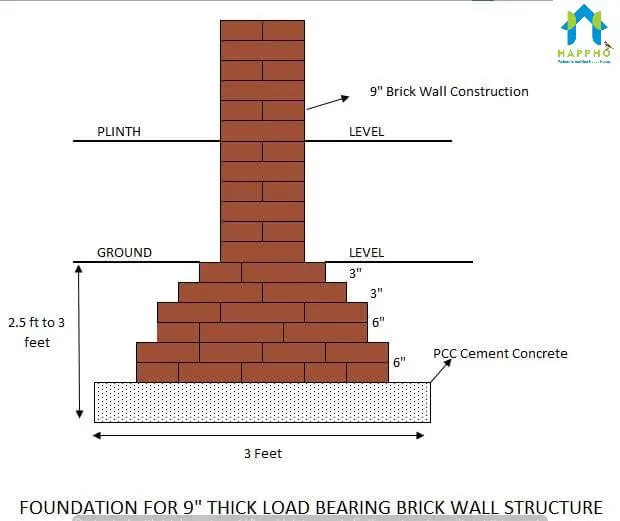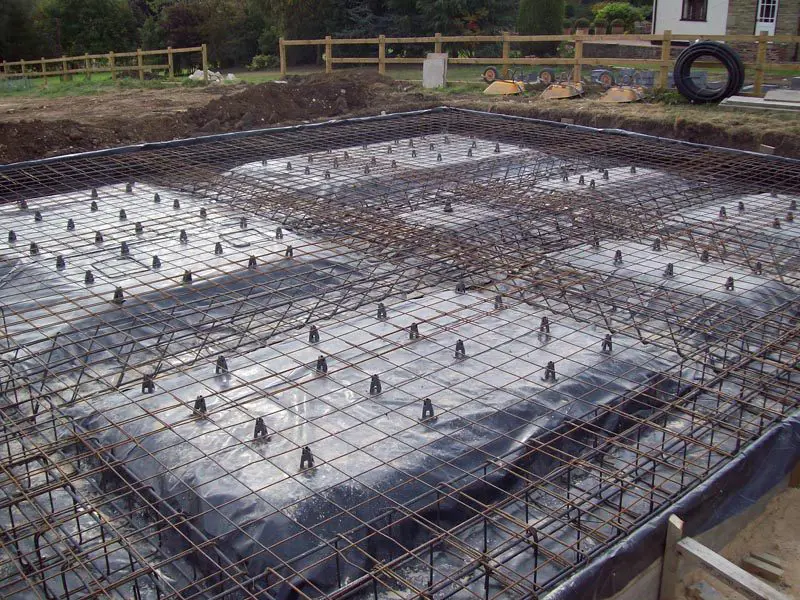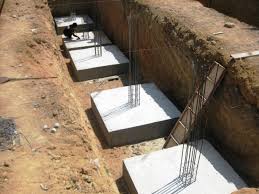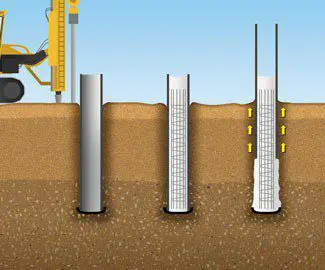Foundation is the part of the structure which transmits the loads acting on the structure and the self-weight of the structure, safely to the ground/subsoil.
The first and foremost consideration while designing the foundation is the type of superstructure and the number for floors to be constructed.
The type of super structure can be classified into 2 types:
- Load Bearing Structure
- Framed Structure
Foundation for Load Bearing Structure (brick Structure)
Although load-bearing structures are very rare now, they are particularly useful for small structures like sheds, garages, etc. They are used by low rise residential houses also (G+1 floor construction). The foundation for load bearing structure can be as show in the drawing below. The foundation runs all along the load bearing walls in this type of structure.

Foundation for Framed Structure (Column Beam Structure)
For low rise framed structures the most common type of foundation used is isolated RCC pad footings with grade beams, made of RCC (reinforced cement concrete).
But with the increase in the number of floors in the structure, the load to be carried by the foundation system increases and consequently the area of the foundation needs to be increased. After the proper calculation of loads, the type of foundation system suitable for the building (superstructure) is decided. In multi-storeyed buildings the loads are concentrated at the point of application, use of pad and pile foundations are common. Where the loads are uniformly distributed, piles are not needed.
The next consideration is the soil type and its SBC (safe bearing capacity). The soil type indicates if the soil is prone to settlement and uplift, and the SBC gives the load bearing capacity of the soil. A soil investigation prior to construction gives the requisite characteristics of the soil, particularly about the depths of the different layers of soil, called soil profile, by drilling bore holes in the site at suitable intervals. If the soil close to the surface is capable of supporting structural loads, then shallow foundations are used, else deep foundations need to be adopted for the structure.
The soil type also gives the depth of the water table. The data from the soil investigation gives enough basis for the selection of the foundation type.
In any case, particular attention shall be paid to:
- Groundwater level
- Underground water courses
- Old drains, wells, & pits
- Old foundations
- Presence of sulphates and other aggressive/injurious chemicals in the groundwater and soil
Suitability of Foundation on the Basis of Soil Type
1. Clayey Soils (Laterite Soils and Black Cotton Soil have high clay content)
- This is the most abundant type of soil in India (on the basis of percentage share of total area). It has a high moisture retention capacity; hence, it is prone to expansion and uplift which results in uneven settlement and cracks in foundation, plinth and grade beams and on-grade floor slabs.
Recommended foundation type for Clayey Soil:
- Raft/Mat foundation is the best foundation type, and ribs and beams can be incorporated into it to increase its stiffness.
- Pile foundation (under-reamed pile, to be exact) is preferable if –
- the loads from the superstructure are high
- raft foundation is not economically feasible
- proper bearing stratum is not available at shallow depths
Best practices of foundation construction in Clayey Soils:
- Collect rainwater (and runoff) and either store it or dispose it in drains via proper drainage structures. This reduces the amount of water infiltrating the soil, and causing expansion.
- The depth of the water table is quite low, which means the water table is closer to the ground surface. It is advisable to extend the depth of the foundation, below the zone prone to moisture content fluctuation.
- If the depth of the black cotton soil at a given site is only 1 to 1.5 m, the entire black cotton soil above the hard bed may be completely removed and the foundation may be laid on the hard bed below.
- The swelling of soil in direct contact with the foundation material causes maximum damage. Hence it is necessary to prevent the direct contact of black cotton soil with masonry work below ground level. These can be achieved by making wider trenches for foundation and filling spaces on the either side of the foundation masonry with sand or moorum.
- One and two storey buildings and residences are particularly vulnerable to damage because they are not heavy enough to suppress the uneven settlement, as compared to multi-storeyed buildings. The structural loads should be balanced properly so that the load on the foundation is as uniform as possible. This should be given due importance while designing the layout/plan of the building.
- Construction in black cotton soil should be undertaken during dry season.

Raft or Matt Footings on Clayey Soils
2. Loamy Soils
Loam soil is the ideal soil for construction: typically it’s a combination of sand, silt and clay. It is dark in color and soft, dry and crumbly to the touch. Loam soil is great for supporting foundations because of its consistently balanced properties, especially how it maintains water at a balanced rate.
Recommended foundation Type for loamy Soils
- Loamy soil is suitable for construction of isolated pad footings. The area and depth is again governed by bearing capacity, depth of groundwater table, and depth of load bearing stratum.
- Isolated pad footings are provided under columns and are joined/tied together by connecting beams. If the building has a single storey then continuous then continuous strip foundation can be used, but isolated RCC pad foundations are preferable provided they are economical.

Isolated Pad Footings on Loamy Soils
3. Dessert Soil (Sandy Soil
Desert soils are basically of sandy texture. This type of soil has poor clay content and also lacks in moisture content.
Recommended Foundation Type for Dessert or Sandy Soil
In desert soils, multi-storeyed buildings usually have pile foundations, especially driven piles or augured cast in-situ piles. In case of loose sand extending to a great depth, raft foundation maybe appropriate as spread footings may settle excessively.

Cast-insitu Pile Foundation in Desert-Soil
4. Silty Soil
Silty soil can be smooth to the touch and retains water longer because of its smaller particles. However, because of its tendency to retain moisture it is cold and drains poorly. This causes the silty soil to expand, pushing against a foundation and weakening it, making it not ideal for support.
Recommended Foundation Type for Silty Soil
- If ‘firm silt’ or ‘firm silty clay’ deposit extending to great depth is available, then RCC spread and isolated pad footings are appropriate. The depth of the foundation should be greater than the zone of erosion and the zone of swelling and shrinkage.

RCC Spread and Isolated Pad Footings for Silty Soil
5. Mountain and Forest Soils
- Mountain soils and forest soils are most likely to have boulders at various depths, so pile foundations are not suitable. Isolated RCC pad foundations under stilts are usually preferred for buildings on sloping grounds.
- For residential buildings with one or two floors, Isolated RCC pad foundations are suitable. For single storeyed buildings RCC strip foundations are suitable.
Careful site selection is important in hilly, mountainous and forest regions/areas. No residential buildings should be constructed on slopes steeper than 25 degrees.
Some Tips for Foundation Selection
- Pile foundations are recommended for high rise buildings and whenever uplift is expected.
- If the allowable bearing capacity is available only at a greater depth, the foundation can be rested at a higher level for economic consideration and the difference in the level between the base of the foundation and the depth at which the allowable bearing capacity occurs can be filled with either –
- Concrete of allowable compressive strength not less than the allowable bearing pressure
- Incompressible fill material for example sand, gravel, in which case the width of the fill should be more than the width of the foundation.
- The design and choice of the foundation system is only as good as its execution in the field, hence the choice of foundation should be made keeping in mind the ease with which it can be executed/constructed at the site. The construction of different types of foundation requires labour of different skillset and different level of skills.





